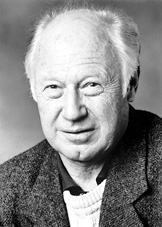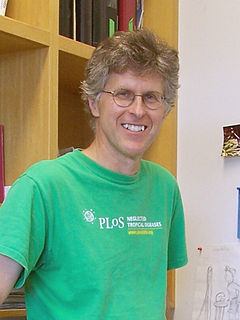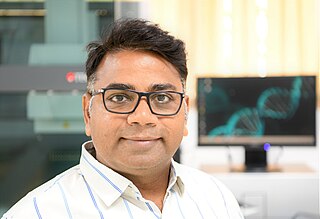
Michael Smith was a British-born Canadian biochemist and businessman. He shared the 1993 Nobel Prize in Chemistry with Kary Mullis for his work in developing site-directed mutagenesis. Following a PhD in 1956 from the University of Manchester, he undertook postdoctoral research with Har Gobind Khorana at the British Columbia Research Council in Vancouver, British Columbia, Canada. Subsequently, Smith worked at the Fisheries Research Board of Canada Laboratory in Vancouver before being appointed a professor of biochemistry in the UBC Faculty of Medicine in 1966. Smith's career included roles as the founding director of the UBC Biotechnology Laboratory and the founding scientific leader of the Protein Engineering Network of Centres of Excellence (PENCE). In 1996 he was named Peter Wall Distinguished Professor of Biotechnology. Subsequently he became the founding director of the Genome Sequencing Centre at the BC Cancer Research Centre.

Leroy "Lee" Edward Hood is an American biologist who has served on the faculties at the California Institute of Technology (Caltech) and the University of Washington. Hood has developed ground-breaking scientific instruments which made possible major advances in the biological sciences and the medical sciences. These include the first gas phase protein sequencer (1982), for determining the amino acids that make up a given protein; a DNA synthesizer (1983), to synthesize short sections of DNA; a peptide synthesizer (1984), to combine amino acids into longer peptides and short proteins; the first automated DNA sequencer (1986), to identify the order of nucleotides in DNA; ink-jet oligonucleotide technology for synthesizing DNA and nanostring technology for analyzing single molecules of DNA and RNA.

Eric Steven Lander is an American mathematician and geneticist who is the 11th Director of the Office of Science and Technology Policy and Science Advisor to the President, serving on the Cabinet in both capacities. Lander is a professor of biology at the Massachusetts Institute of Technology (MIT), a professor of systems biology at Harvard Medical School, a former member of the Whitehead Institute, and the founding director of the Broad Institute. He is a 1987 MacArthur Fellow and Rhodes Scholar. Lander co-chaired President Barack Obama's Council of Advisors on Science and Technology.

George McDonald Church is an American geneticist, molecular engineer, and chemist. He is the Robert Winthrop Professor of Genetics at Harvard Medical School, Professor of Health Sciences and Technology at Harvard and MIT, and a founding member of the Wyss Institute for Biologically Inspired Engineering. As of March 2017, Church serves as a member of the Bulletin of the Atomic Scientists' Board of Sponsors.

The U.S. Department of Energy (DOE) Joint Genome Institute (JGI), first located in Walnut Creek then Berkeley, California, was created in 1997 to unite the expertise and resources in genome mapping, DNA sequencing, technology development, and information sciences pioneered at the DOE genome centers at Lawrence Berkeley National Laboratory, Lawrence Livermore National Laboratory (LLNL) and Los Alamos National Laboratory (LANL). As a DOE Office of Science User Facility of Berkeley Lab, the JGI staff is composed of employees from Berkeley Lab, LLNL and the HudsonAlpha Institute for Biotechnology. The JGI also collaborates with other DOE-supported programs and facilities, such as the Environmental Molecular Sciences Laboratory at Pacific Northwest National Laboratory (PNNL), the National Energy Research Scientific Computing Center, or NERSC, and the DOE Bioenergy Research Centers.

Patrick O'Reilly Brown is an American scientist who is the chief executive and founder of Impossible Foods Inc. and professor emeritus in the department of biochemistry at Stanford University. Brown is co-founder of the Public Library of Science, inventor of the DNA microarray, and a former investigator at Howard Hughes Medical Institute.
The National Academy of Sciences Award in Chemical Sciences is awarded for innovative research in the chemical sciences that in the broadest sense contributes to a better understanding of the natural sciences and to the benefit of humanity.
The UNESCO Science Prize is a biennial scientific prize awarded by the United Nations Educational, Scientific and Cultural Organization (UNESCO) to "a person or group of persons for an outstanding contribution they have made to the technological development of a developing member state or region through the application of scientific and technological research ."
The Association of Biomolecular Resource Facilities (ABRF) is dedicated to advancing core and research biotechnology laboratories through research, communication, and education. ABRF members include over 1200 scientists representing 340 different core laboratories in 41 countries, including those in industry, government, academic and research institutions.
The Willard Gibbs Award, presented by the Chicago Section of the American Chemical Society, was established in 1910 by William A. Converse (1862–1940), a former Chairman and Secretary of the Chicago Section of the society and named for Professor Josiah Willard Gibbs (1839–1903) of Yale University. Gibbs, whose formulation of the Phase Rule founded a new science, is considered by many to be the only American-born scientist whose discoveries are as fundamental in nature as those of Newton and Galileo.
The Richard Lounsbery Award is given to American and French scientists, 45 years or younger, in recognition of "extraordinary scientific achievement in biology and medicine."
The John J. Carty Award for the Advancement of Science is awarded by the U.S. National Academy of Sciences "for noteworthy and distinguished accomplishments in any field of science within the charter of the Academy". Established by the American Telephone and Telegraph Company (AT&T) and first awarded in 1932, the medal has been awarded in specific fields since 1961. The recipient is awarded a $25,000 prize.

Gajendra Pal Singh Raghava is an Indian bio-informatician and head of computational biology at the Indraprastha Institute of Information Technology.
Harvey Prize is an annual Israeli award for breakthroughs in science and technology, as well as contributions to peace in the Middle East granted by the Technion in Haifa.
The NAS Award in Molecular Biology is awarded by the U.S. National Academy of Sciences "for recent notable discovery in molecular biology by a young scientist who is a citizen of the United States." It has been awarded annually since its inception in 1962.
The NAS Award for Scientific Reviewing is awarded by the U.S. National Academy of Sciences "to recognize authors whose reviews have synthesized extensive and difficult material, rendering a significant service to science and influencing the course of scientific thought." It has been awarded annually in specific fields since 1979.
The NAS Award for Chemistry in Service to Society is awarded by the U.S. National Academy of Sciences "for contributions to chemistry, either in fundamental science or its application, that clearly satisfy a societal need." It has been awarded every two years since its inception in 1991.

Rajeev Kumar Varshney is an agricultural scientist, specializing in genomics, genetics, molecular breeding and capacity building in developing countries. Varsheny is currently the Research Program Director- Genetic Gains that includes several units viz. Genomics & Trait Discovery, Forward Breeding, Pre-Breeding, Cell, Molecular Biology & Genetic Engineering, Seed Systems, Biotechnology- ESA, Sequencing and Informatics Services Unit, and Genebank ; and Director, Center of Excellence in Genomics & Systems Biology at the International Crops Research Institute for the Semi-Arid Tropics (ICRISAT), a global agricultural research institute. He holds Adjunct/Honorary/Visiting Professor positions at 10 academic institutions in Australia, China, Ghana, Hong Kong and India, including Murdoch University, The University of Western Australia, University of Queensland, West Africa Centre for Crop Improvement, University of Hyderabad, Chaudhary Charan Singh University and Professor Jayashankar Telangana State Agricultural University.
Asis Datta is an Indian biochemist, molecular biologist and genetic engineer, known for his research on genetically modified foods and food nutritional security. He was the founding Director of the National Institute of Plant Genome Research and is credited with the discovery of genes that assist in extended preservation of fruits and vegetables. He is a recipient of the Shanti Swarup Bhatnagar Award, the highest Indian award and in the Science category, and was awarded the fourth highest civilian award of the Padma Shri, by the Government of India, in 1999. In 2008, he was included again in the Republic Day Honours list for the third highest civilian honour of the Padma Bhushan.
Ganugapati Sree Rama Subba Rao is an Indian natural product chemist and a former chair of the department of sciences at the Indian Institute of Science (IISc). He is known for his researches on dihydroaromatics obtained through Birch reduction of aromatic compounds and is an elected fellow of the Indian National Science Academy, and the Indian Academy of Sciences. The Council of Scientific and Industrial Research, the apex agency of the Government of India for scientific research, awarded him the Shanti Swarup Bhatnagar Prize for Science and Technology, one of the highest Indian science awards, in 1982, for his contributions to chemical sciences.